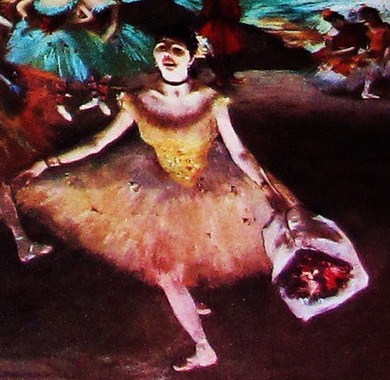Search:: Artists Alphabetically Symbolism 50 Greatest Paintings Art Movements
Edgar Degas
1834-1917
French Impressionist Painter and Sculptor
His Style Was Influenced by the following Painters - Manet, Jean Auguste Ingres, Monet, Renoir, and the Renaissance.
Education - Ecole des Beaux Art, Paris, France
Mediums - oil on canvas, pastel, drawing, bronze
Cause of Death - Degas had retinal eye disease and was nearly blind when he died of old age.

Description of Edgar Degas Style
Degas's painting style, subject matter, and psychology of movement set him apart from the other Impressionists. He sought to capture the essence of the subject through effects created by using light and color in new and innovative ways. Degas never worked outside, preferring the indoor studio environment. Degas once stated "No art is less spontaneous than mine. What I do is the result of reflection and the study of the great masters." He executed his masterpieces from live models with bold strokes and graceful applications of color. Over time his eye sight deteriorated to the point of near blindness.
Edgar Degas felt that Parisian life should be recorded in a lively vibrant palette. He focused on ballet dancers, historical subjects, portraits of his family and friends and the joyous eccentricities of Parisian life. According to Art historian Camille Mauclair "Degas is beyond all a draughtsman of the first order. His spirit is quite classical. He commenced by making admirable copies of the Italian Primitives, notably of Fra Angelico, and the whole first series of his works speaks of that influence: portraits, heads of deep, mat, amber colour, on a ground of black or grey tones, remarkable for a severity of intense style, and for the rare gift of psychological expression. To find the equal of these faces—after having stated their classic descent—one would have to turn to the beautiful things by Ingres, and certainly Degas is, with Ingres, the most learned, the most perfect French draughtsman of the nineteenth century. An affirmation of this nature is made to surprise those who judge.
Camille Mauclair Further states "Impressionism with preconceived ideas. It is none the less true that, if a series of Degas's first portraits were collected, the comparison would force itself upon one's mind irrefutably. In face of the idealist painting of Romanticism, Ingres represented quite clearly the cult of painting for its own sake. His ideas were mediocre, and went scarcely beyond the poor, conventional ideal of the Academy; but his genius was so great, that it made him paint, together with his tedious allegories, some incomparable portraits and nudes. He thought he was serving official Classicism, which still boasts of his name, but in reality he dominated it; and, whilst he was an imitator of Raphael, he was a powerful Realist. The Impressionists admire him as such, and agree with him in banishing from the art of painting all literary imagination, whether it be the tedious mythology of the School, or the historical anecdote of the Romanticists. Degas and Besnard admire Ingres as colossal draughtsman, and, beyond all, as man who, in spite of the limitations of his mind, preserved the clear vision of the mission of his art at a time when art was used for the expression of literary conceptions."
Edgar Degas Art Quotations
One must do the same subject over again
ten times, a hundred times. In art nothing must resemble an accident,
not even movement. --- Edgar Degas
In painting you must give the idea of the true by means of the false. --- Edgar Degas
Make a drawing. Start all over again. Trace it. Start it and trace it
again. You must do over the same subject ten times, a hundred times. In
art nothing must appear accidental even a movement. --- Edgar Degas
These women of mine are decent, simple human beings who have no other
concern than that of their physical condition... it is as though one
were watching through a keyhole. --- Edgar Degas
Only when he no longer knows what he is doing does the painter do good things. --- Edgar Degas
It is a tremendous responsibility to leave anything behind in bronze?that medium is for eternity. --- Edgar Degas
The fascinating thing, is not to show the source of light, but the effect of light. --- Edgar Degas
Realism is more important than the sentiment of the picture.--- Edgar Degas
The true traveler never arrives. .--- Edgar Degas
Drawing is not what one sees but what one can make others see. -- Edgar Degas
Art is not what you see, but what you make others see. ---Edgar Degas
---Edgar Degas
Painting is easy when you don't know how, but very difficult when you do. ---Edgar Degas
The Principal Impressionist Painters
Require more information about Edgar Degas in Art History? Type your query in art into the google search box below and poke around every nook and cranny of the known universe for information this subject. Search Here
© HistoryofPainters.com If you like this page and wish to share it, you are welcome to link to it, with our thanks.
If you feel you have worthwhile information you would like to contribute we would love to hear from you. We collect essential biographical information and artist quotes from folks all over the globe and appreciate your participation. When submitting please, if possible, site the source and provide English translation. email the editor
| Byzantine 500-1450 | Romanesque 950-1250 | ||||||||||
| Gothic 1150-1580 | Florentine | ||||||||||
| Sienese School 1150-1550 | Venetian | ||||||||||
| Early Renaissance 1350-1500 | |||||||||||
| High Renaissance 1450-1530 | |||||||||||
| Northern Renaissance 1350-1600 | |||||||||||
| Mannerism 1510-1600 | |||||||||||
| Baroque 1600-1750 | |||||||||||
| Rococo 1710-1790 | |||||||||||
| Neoclassical 1740-1835 | |||||||||||
| Romanticism 1750-1860 | |||||||||||
| Hudson River School 1825-1880 | |||||||||||
| Orientalism 1800-1885 | |||||||||||
| Academic Classicism 1865-1920 | |||||||||||
| Victorian Classicism 1845-1895 | |||||||||||
| Pre-Raphaelite 1840-1855 | |||||||||||
Impressionism 1860-1895
|